technical data MERCEDES-BENZ S CLASS 2019 Owners Manual
[x] Cancel search | Manufacturer: MERCEDES-BENZ, Model Year: 2019, Model line: S CLASS, Model: MERCEDES-BENZ S CLASS 2019Pages: 578, PDF Size: 23.31 MB
Page 6 of 578

Wheels and tires......................................434Notes on noise or unusual handlingchar‐acteristics ...................................................434Notes onregularlyinspecting wheels andtires ............................................................ 434Notes on snowchains ................................ 435Tirepressure .............................................. 435Loadingthevehicle ....................................442Tirelabeling ................................................446Definition oftermsfor tires and loading ..... 451Changing a wheel ....................................... 454
Technical data..........................................464Notes ontechnical data.............................. 464Vehicle electronics .....................................464Vehicle identification plate, VIN andengine numberoverview ............................ 466Operatingfluids .......................................... 468Vehicle data ................................................475
Display messages andwarning/indi‐cator lamps...............................................478Displaymessages .......................................478Warning and indicator lamps ...................... 523
Index.........................................................536
4Contents
Page 26 of 578

&WARNINGRisk of accident duetoobjects inthe driver'sfootwell
Objects inthe driver'sfootwell may impedepedal travel or block a depressed pedal.
This jeopardizesthe operating androadsafety ofthevehicle.
#Stowall objects inthevehicle securelysothattheycannotgetintothe driver'sfootwell.
#Always installthefloor mats securelyand as prescribed in ordertoensurethatthere is always sufficientroomforthe pedals.
#Do not use loosefloor mats and do notplacefloor mats ontop of one another.
*NOTEBattery discharging from usingdevices connectedtothe diagnosticsconnection
Using devices atthe diagnostics connectiondrainsthe battery.
#Checkthechargelevel ofthe battery.
#Ifthechargelevel is low,chargethebattery,e.g.bydriving a considerabledistance.
Connecting equipmenttothe diagnostics con‐nection can leadtoemissions monitoring infor‐mation beingreset,forexample. This may leadtothevehiclefailingtomeettherequirements ofthe next emissions inspection duringthe maininspection.
Qualified specialistworkshop
Plug-inhybrid:observethe notes inthe Supple‐ment. Otherwise,you mayfailtorecognize dan‐gers.
An authorized Mercedes-Benz Center is aquali‐fied specialistworkshop. It hasthe necessaryspecial skills,tools andqualificationstocor‐rectly carryouttheworkrequired onyourvehi‐cle. This particularlyappliestosafety-relevantworks.
Always havethefollowingworkcarried out onyourvehicle at aqualified specialistworkshop:
RSafety-relevantwork
RService and maintenancework
RRepairwork
RModifications aswell as installations andconversions
RWorkon electronic components
Mercedes‑Benzrecommends a Mercedes‑Benzservice center.
Correct use ofthevehicle
Ifyouremoveanywarningstickers,you orotherscouldfailtorecognize certain dangers. Leavewarningstickersin position.
Observethefollowing information in particularwhen drivingyourvehicle:
Rthe safety notes inthis manual
Rtechnical dataforthevehicle
Rtrafficrules andregulations
24General notes
Page 28 of 578
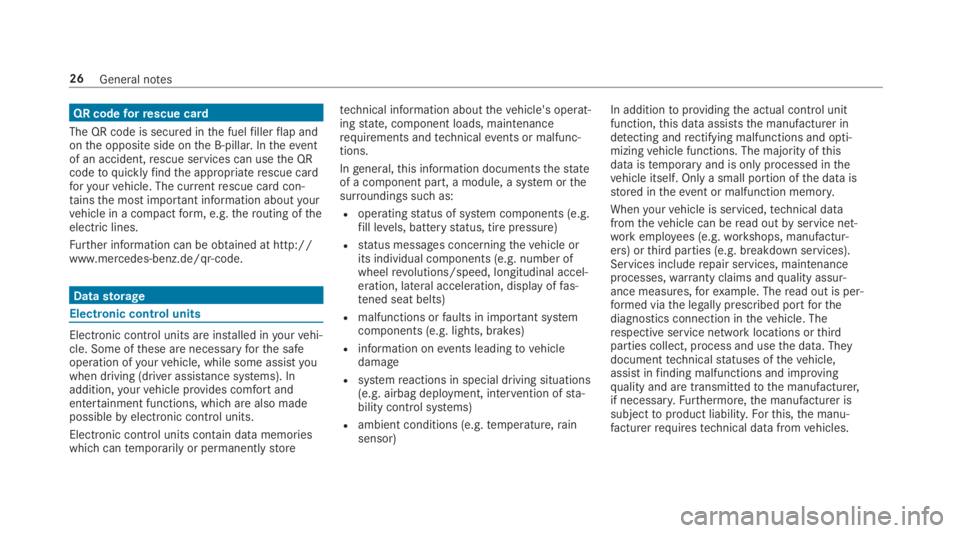
QR codeforrescue card
The QR code is secured inthe fuelfillerflap andonthe opposite side onthe B-pillar. Intheeventof an accident,rescue services can usethe QRcodetoquicklyfindthe appropriaterescue cardforyourvehicle. The currentrescue card con‐tainsthe most important information aboutyourvehicle in a compactform, e.g.therouting oftheelectric lines.
Further information can be obtained at http://www.mercedes-benz.de/qr-code.
Datastorage
Electronic control units
Electronic control units are installed inyourvehi‐cle. Some ofthese are necessaryforthe safeoperation ofyourvehicle, while some assistyouwhen driving (driver assistance systems). Inaddition,yourvehicle provides comfortandentertainment functions, which are also madepossiblebyelectronic control units.
Electronic control units contain datamemorieswhichcantemporarily or permanentlystore
technical information aboutthevehicle's operat‐ingstate, component loads, maintenancerequirements andtechnicalevents or malfunc‐tions.
Ingeneral,this information documentsthestateof a component part, a module, a system orthesurroundings such as:
Roperatingstatus of system components (e.g.fill levels, batterystatus, tire pressure)
Rstatus messages concerningthevehicle orits individual components (e.g. number ofwheelrevolutions/speed, longitudinal accel‐eration, lateral acceleration, display offas‐tened seat belts)
Rmalfunctions orfaults in important systemcomponents (e.g. lights, brakes)
Rinformation onevents leadingtovehicledamage
Rsystemreactions in special driving situations(e.g. airbag deployment, intervention ofsta‐bility control systems)
Rambient conditions (e.g.temperature,rainsensor)
In additiontoprovidingthe actual control unitfunction,this data assiststhe manufacturer indetecting andrectifying malfunctions and opti‐mizingvehicle functions. The majority ofthisdata istemporary and is only processed inthevehicle itself. Only a small portion ofthe data isstored intheevent or malfunction memory.
Whenyourvehicle is serviced,technical datafromthevehicle can beread outbyservice net‐workemployees (e.g.workshops, manufactur‐ers) orthird parties (e.g. breakdown services).Services includerepair services, maintenanceprocesses,warranty claims andquality assur‐ance measures,forexample. Theread out is per‐formed viathe legally prescribed portforthediagnostics connection inthevehicle. Therespective service network locations orthirdparties collect, process and usethe data. Theydocumenttechnicalstatuses ofthevehicle,assist infinding malfunctions and improvingquality and are transmittedtothe manufacturer,if necessary.Furthermore,the manufacturer issubjecttoproduct liability.Forthis,the manu‐facturerrequirestechnical datafromvehicles.
26General notes
Page 132 of 578

characteristics aswell asthesteering andbrakingcharacteristicschange. During cor‐nering,thevehicle tilts morestrongly andmayreact more sluggishlytosteering move‐ments.
Ifyouexceedthe maximumroof load,thedrivingcharacteristics, aswell asthesteer‐ing and brakingcharacteristics, will begreatlyimpaired.
#Always comply withthe maximumroofload and adjustyour drivingstyle.
You willfind information onthe maximumroofload inthe "Technical data" section.
*NOTEVehicle damage from non-approvedroofracks
Thevehicle could be damagedbyroofrackswhich havenot beentested and approvedbyMercedes-Benz.
#Only useroofrackstested andapprovedbyMercedes-Benz.
#Depending onthevehicle equipment,ensurethat whentheroofrackis instal‐led:RThe sliding sunroof can be fullyraised.
RThe trunk lid can be fully opened.
#Positionthe load ontheroofrackinsuch awaythatthevehicle will not sus‐tain damageeven when it is in motion.
*NOTEDamagetothe sliding sunroofwhen aroofrackis installed
The sliding sunroof may be damagedbytheroofrackifyou attempttoopen it whentheroofrackis installed.
#Do not openthe sliding sunroof whentheroofrackis installed.
In ordertoallowventilation ofthevehicleinterior,you canraisethe sliding sunroof.
*NOTEDamagetothe covers
The coversmay be damaged and scratchedwhen being opened.
#Do not use metallic or hard objects.
#Carefullyfoldthe covers1upwards inthedirection ofthe arrow.
13 0Seats andstowing
Page 466 of 578
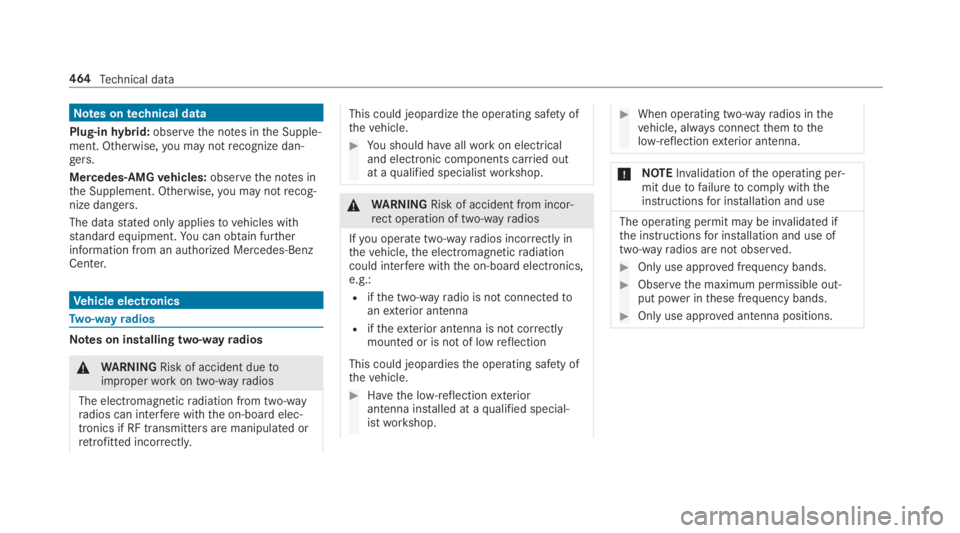
Notes ontechnical data
Plug-inhybrid:observethe notes inthe Supple‐ment. Otherwise,you may notrecognize dan‐gers.
Mercedes-AMGvehicles:observethe notes inthe Supplement. Otherwise,you may notrecog‐nize dangers.
The datastated onlyappliestovehicles withstandard equipment.You can obtain furtherinformation from an authorized Mercedes-BenzCenter.
Vehicle electronics
Two-wayradios
Notes on installing two-wayradios
&WARNINGRisk of accident duetoimproperworkon two-wayradios
The electromagneticradiation from two-wayradios can interferewiththe on-board elec‐tronics if RF transmittersare manipulated orretrofitted incorrectly.
This could jeopardizethe operating safety ofthevehicle.
#You should haveallworkon electricaland electronic components carried outat aqualified specialistworkshop.
&WARNINGRisk of accident from incor‐rect operation of two-wayradios
Ifyou operate two-wayradios incorrectly inthevehicle,the electromagneticradiationcould interferewiththe on-board electronics,e.g.:
Rifthe two-wayradio is not connectedtoanexterior antenna
Riftheexterior antenna is not correctlymounted or is not of lowreflection
This could jeopardiesthe operating safety ofthevehicle.
#Havethe low-reflectionexteriorantenna installed at aqualified special‐istworkshop.
#When operating two-wayradios inthevehicle, always connectthemtothelow-reflectionexterior antenna.
*NOTEInvalidation ofthe operating per‐mit duetofailuretocomply with theinstructionsfor installation and use
The operating permit may be invalidated ifthe instructionsfor installation and use oftwo-wayradios are not observed.
#Only use approved frequency bands.
#Observethe maximum permissible out‐put power inthese frequency bands.
#Only use approved antenna positions.
464Technical data
Page 467 of 578
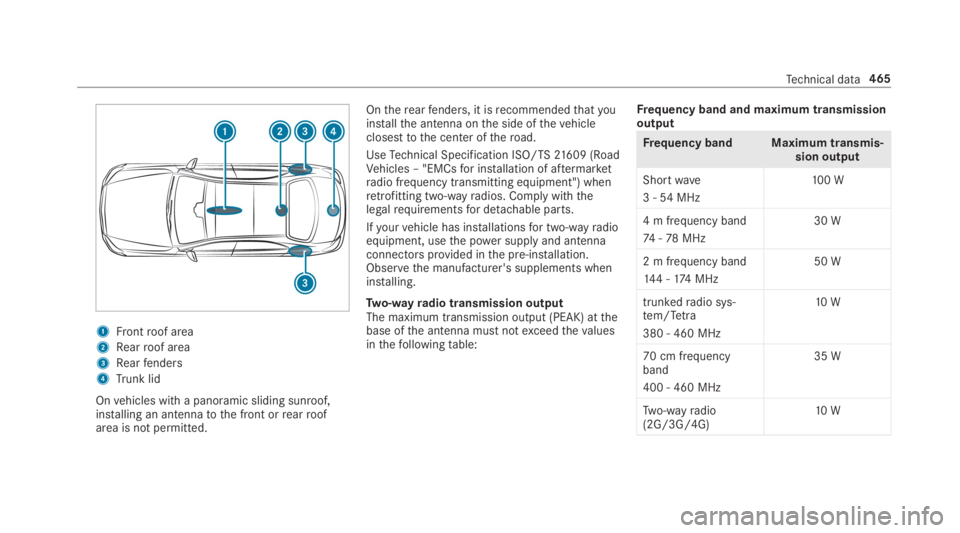
1Frontroof area
2Rearroof area
3Rearfenders
4Trunk lid
Onvehicles with a panoramic sliding sunroof,installing an antennatothe front orrearroofarea is not permitted.
Ontherearfenders, it isrecommendedthatyouinstallthe antenna onthe side ofthevehicleclosesttothe center oftheroad.
UseTechnical Specification ISO/TS21609 (RoadVehicles – "EMCsfor installation of aftermarketradio frequency transmitting equipment") whenretrofitting two-wayradios. Comply withthelegalrequirementsfor detachable parts.
Ifyourvehicle has installationsfor two-wayradioequipment, usethe power supplyand antennaconnectorsprovided inthe pre-installation.Observethe manufacturer's supplements wheninstalling.
Two-wayradio transmission outputThe maximum transmission output (PEAK) atthebase ofthe antenna must notexceedthevaluesinthefollowingtable:
Frequency band and maximum transmissionoutput
Frequency band Maximum transmis‐sion output
Shortwave
3 -54MHz
100 W
4 m frequency band
74-78MHz
30 W
2 m frequency band
144 -174 MHz
50 W
trunkedradio sys‐tem/Tetra
380 - 460 MHz
10 W
70 cm frequencyband
400 - 460 MHz
35 W
Two-wayradio(2G/3G/4G)10 W
Technical data465
Page 468 of 578

Thefollowing can be used inthevehicle withoutrestrictions:
RRF transmitters witha maximum transmis‐sion output of upto100 mW
RRF transmitters with transmitter frequenciesinthe 380 -410 MHz frequency band and amaximum transmission output of upto2 W(trunkedradio system/Tetra)
Rmobile phones (2G/3G/4G)
There are norestrictions when positioningtheantenna onthe outside ofthevehiclefor somewavebands.
This appliestothefollowingwavebands:
Rtrunkedradio system/Tetra
R70 cm frequency band
R2G/3G/4G
Vehicle identification plate, VIN and enginenumberoverview
Vehicle identification plate
Vehicle identification plate (USA only)
1Permissiblegrossweight
2Permissible front axle load
3Permissiblerear axle load
4Paint code
5VIN (vehicle identification number)
466Technical data
Page 469 of 578
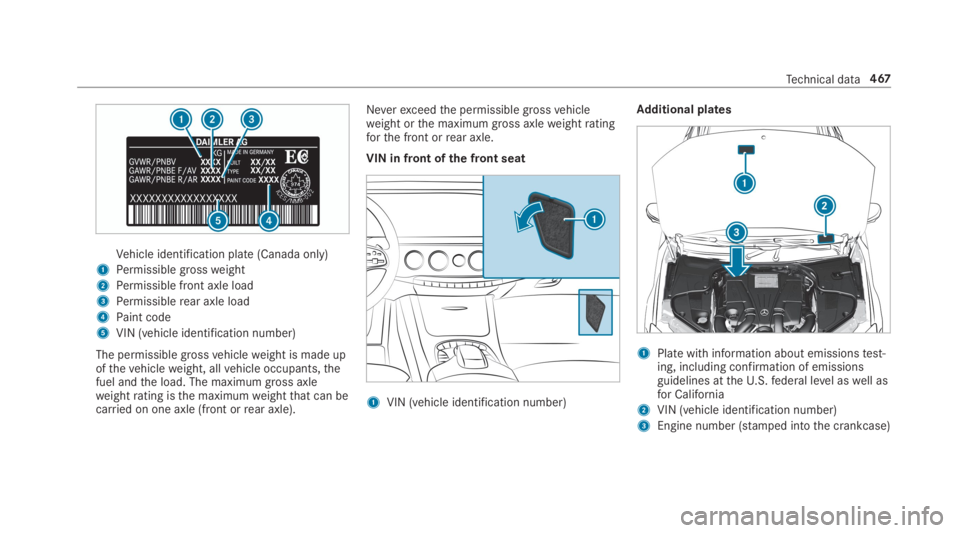
Vehicle identification plate (Canada only)
1Permissiblegrossweight
2Permissible front axle load
3Permissiblerear axle load
4Paint code
5VIN (vehicle identification number)
The permissible grossvehicleweight is made upofthevehicleweight, allvehicle occupants,thefuel andthe load. The maximum gross axleweightrating isthe maximumweightthat can becarried on one axle (front orrear axle).
Neverexceedthe permissible grossvehicleweight orthe maximum gross axleweightratingforthe front orrear axle.
VIN in front ofthe front seat
1VIN (vehicle identification number)
Additional plates
1Platewith information about emissionstest‐ing, including confirmation of emissionsguidelines attheU.S.federal level aswell asfor California
2VIN (vehicle identification number)
3Engine number (stamped intothe crankcase)
Technical data467
Page 470 of 578
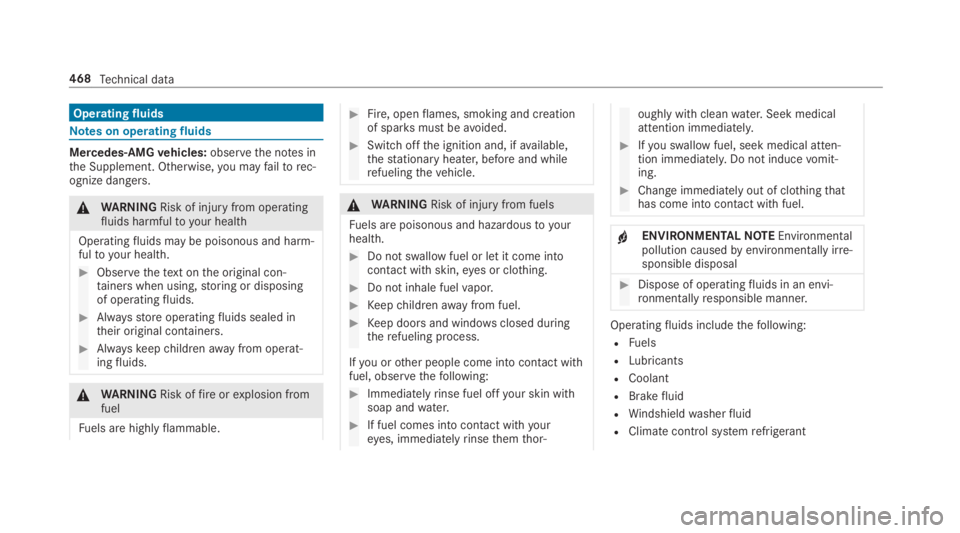
Operatingfluids
Notes on operatingfluids
Mercedes-AMGvehicles:observethe notes inthe Supplement. Otherwise,you mayfailtorec‐ognize dangers.
&WARNINGRisk of injuryfrom operatingfluids harmfulto your health
Operatingfluids may be poisonous and harm‐fulto your health.
#Observethetext onthe original con‐tainers when using,storing or disposingof operatingfluids.
#Alwaysstore operatingfluids sealed intheir original containers.
#Alwayskeepchildrenawayfrom operat‐ingfluids.
&WARNINGRisk offireorexplosion fromfuel
Fuels are highlyflammable.
#Fire, openflames, smoking and creationof sparksmust beavoided.
#Switchoffthe ignition and, ifavailable,thestationary heater, before and whilerefuelingthevehicle.
&WARNINGRisk of injuryfrom fuels
Fuels are poisonous and hazardousto yourhealth.
#Do not swallow fuel or let it come intocontact with skin,eyes or clothing.
#Do not inhale fuelvapor.
#Keepchildrenawayfrom fuel.
#Keep doors and windowsclosed duringtherefueling process.
Ifyou orother people come into contact withfuel, observethefollowing:
#Immediatelyrinse fuel offyour skin withsoap andwater.
#If fuel comes into contact withyoureyes, immediatelyrinsethemthor‐
oughly with cleanwater.Seek medicalattention immediately.
#Ifyou swallow fuel, seek medical atten‐tion immediately.Do not inducevomit‐ing.
#Change immediately out of clothingthathas come into contact withfuel.
+ENVIRONMENTALNOTEEnvironmentalpollution causedbyenvironmentally irre‐sponsible disposal
#Dispose of operatingfluids in an envi‐ronmentallyresponsible manner.
Operatingfluids includethefollowing:
RFuels
RLubricants
RCoolant
RBrakefluid
RWindshieldwasherfluid
RClimate control systemrefrigerant
468Technical data
Page 471 of 578
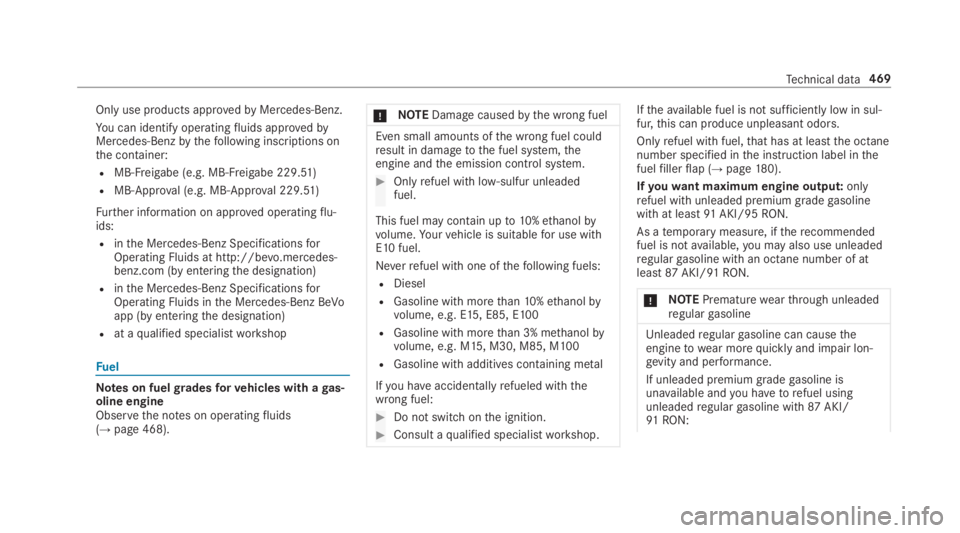
Only use products approvedbyMercedes-Benz.
You can identify operatingfluids approvedbyMercedes-Benzbythefollowing inscriptions onthe container:
RMB-Freigabe (e.g. MB-Freigabe 229.51 )
RMB-Approval (e.g. MB-Approval 229.51)
Further information on approved operatingflu‐ids:
Rinthe Mercedes-Benz SpecificationsforOperating Fluids at http://bevo.mercedes-benz.com (by enteringthe designation)
Rinthe Mercedes-Benz SpecificationsforOperating Fluids inthe Mercedes-Benz BeVoapp (by enteringthe designation)
Rat aqualified specialistworkshop
Fuel
Notes on fuelgradesforvehicles with agas‐oline engineObservethe notes on operatingfluids(→page 468).
*NOTEDamagecausedbythe wrong fuel
Even small amounts ofthe wrong fuel couldresult in damagetothe fuel system,theengine andthe emission control system.
#Onlyrefuel with low-sulfur unleadedfuel.
This fuel may contain upto10%ethanolbyvolume.Yourvehicle is suitablefor use withE10 fuel.
Neverrefuel with one ofthefollowing fuels:
RDiesel
RGasoline with morethan10%ethanolbyvolume, e.g. E15, E85, E100
RGasoline with morethan 3% methanolbyvolume, e.g. M15, M30, M85, M100
RGasoline with additives containing metal
Ifyou haveaccidentallyrefueled withthewrong fuel:
#Do not switchonthe ignition.
#Consult aqualified specialistworkshop.
Iftheavailable fuel is not sufficiently low in sul‐fur,this can produce unpleasant odors.
Onlyrefuel with fuel,that has at leastthe octanenumber specified inthe instruction label inthefuelfillerflap (→page180).
Ifyouwant maximum engine output:onlyrefuel with unleaded premium gradegasolinewith at least91AKI/95RON.
As atemporary measure, iftherecommendedfuel is notavailable,you may also use unleadedregulargasoline with an octane number of atleast87AKI/91RON.
*NOTEPrematurewearthrough unleadedregulargasoline
Unleadedregulargasoline can causetheenginetowear morequickly and impair lon‐gevity and performance.
If unleaded premium gradegasoline isunavailable andyou havetorefuel usingunleadedregulargasoline with87AKI/91RON:
Technical data469